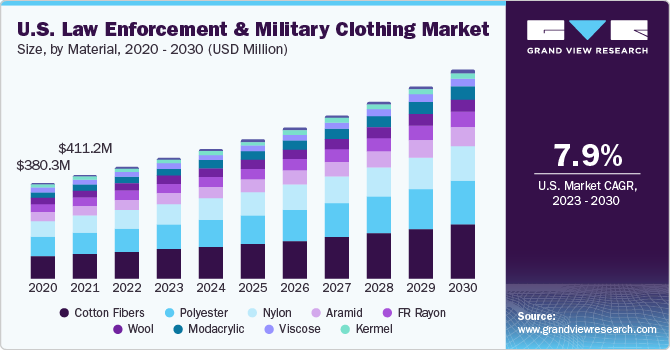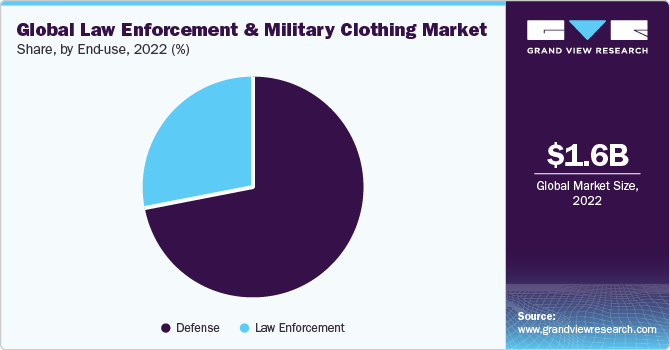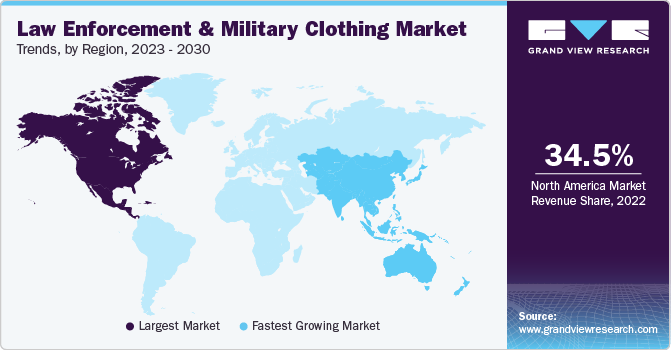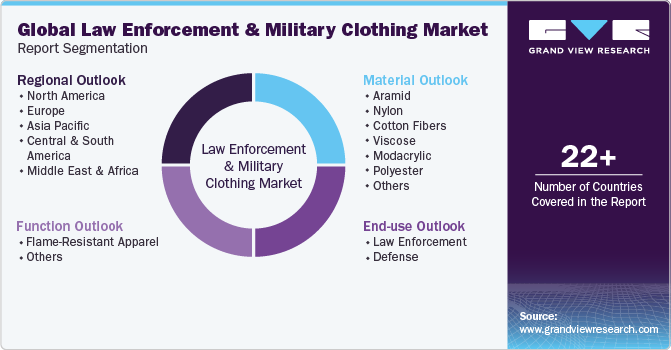- Home
- »
- Smart Textiles
- »
-
Law Enforcement And Military Clothing Market Report, 2030GVR Report cover
![Law Enforcement And Military Clothing Market Size, Share & Trends Report]()
Law Enforcement And Military Clothing Market Size, Share & Trends Analysis Report By Function (Flame-resistant Apparel, Others), By Material (Aramid, Nylon), By End-Use (Law Enforcement, Defense), By Region, And Segment Forecasts, 2023 - 2030
- Report ID: GVR-3-68038-905-0
- Number of Report Pages: 260
- Format: PDF, Horizon Databook
- Historical Range: 2018 - 2021
- Forecast Period: 2023 - 2030
- Industry: Advanced Materials
Law Enforcement And Military Clothing Market Size & Trends
The global law enforcement and military clothing market size was valued at USD 1,550.0 million in 2022 and is anticipated to grow at a CAGR of 9.2% from 2023 to 2030. Rising awareness regarding the safety of law enforcement and military personnel is expected to boost market growth over the forecast period. Law enforcement personnel are responsible for maintaining the internal law and order of a country. Rising awareness among youth regarding serving the country is anticipated to boost the number of recruits in both military and law enforcement services. Furthermore, an increase in the number of field agents, owing to the advanced nature of crimes, is also expected to drive the law enforcement clothing market.

The ability of cotton fiber to be converted into breathable textile makes it an ideal raw material for law enforcement and military clothing. Besides, the low cost of cotton fiber is expected to augment its demand for manufacturing law enforcement clothing over the forecast period.
Military and law enforcement personnel are exposed to severe environmental conditions on duty. As a result, the apparel used by such personnel requires to be made from a fabric that offers protection in harsh external conditions. The fabric is designed to provide a significant amount of water and UV resistance. Furthermore, the apparel offers elasticity, insulation, durability, and comfort to the wearer.
Military and law enforcement personnel are supplied with the clothing through stores in respective departments such as Army, Navy, Air Force, and Police Force. The presence of online garment stores for military and law enforcement clothing, such as Patrolstore and Arktis Endurance Textiles Ltd., aids in ensuring a continuous supply of clothing for the military personnel in their respective country.
Conflicts such as ongoing wars in countries like Iran, Yemen, Afghanistan, Syria, Libya, Ukraine, Israel, Palestine and South Sudan are anticipated to boost the number of military personnel being recruited, thereby, positively impacting the market. Also, an increasing number of natural calamities such as floods, cyclones, earthquakes, forest fires, and tsunamis are anticipated to boost the demand for law enforcement officers and military officers, which are required for disaster management, thereby augmenting the market growth.
When operating on the field, law enforcement officials and military personnel must wear a certain uniform in order to ensure their safety and facilitate identification. The clothing is designed according to the personnel’s activity type, service branch, rank, and designation. The uniform is required in the fields of military and law enforcement while personnel are on duty or on the grounds of associated facilities.
The demand for law enforcement and military clothing is expected to increase significantly during the forecast period due to rising military spending around the world. Furthermore, increased public concern about the safety of law enforcement and military personnel is likely to boost market expansion throughout the projection period.
Increased military spending by various countries, combined with an increasing number of military recruits, are expected to drive demand for military clothing throughout the forecast period. In addition, promotion in the ranks of the workforce also necessitates a new set of clothing, which is expected to fuel the market growth over the forecast period.
The rising technical breakthroughs have increased the use of nanotechnology in law enforcement and military clothing. The use of nanotechnology assists in the production of textiles with improved properties. The nano-finishing procedure, for example, offers nano-armor, which is responsible for weaving threads into thin pads. These tiny pads can sense the impact of bullets or shrapnel and automatically harden the material, making the pad impregnable and shielding the troops. The aforementioned benefits of nanotechnology in law enforcement and military clothing are expected to boost market growth.
Rising young interest in serving their country is expected to increase the number of volunteer recruits for both the military and law enforcement. Additionally, it is anticipated that the law enforcement agencies quick expansion of training initiatives would lead to more effective operations, which will increase promotions and boost the market for law enforcement equipment. The market for law enforcement and military clothing is also anticipated to be driven by the rising number of field agents as a result of the advanced nature of crimes.
There are several military forces and law enforcement organizations operating in the Mexico region, including the Mexican Armed Forces, the Federal Ministerial Police, and the Federal Police. These organizations employ a variety of people in a variety of positions, each of whom is given a department-specific uniform. The necessity for uniforms from rising recruiting in the aforementioned organizations is projected to fuel the demand for law enforcement and military clothing.
The market is highly regulated by several government organizations that create, develop, and enforce regulations and standards for military clothing. Manufacturers as well as the personnel that uses the military clothing are mandated to comply with the manufacturing standards and possession laws. Regulations such as EN ISO 11612:2008, ISO 13688:2012, and others specify requirements for garments, performance, and size designation with other standards containing requirements for specific performance.
The existence of several standards relating to military clothing complicates the process. Furthermore, the demand for highly specialized technology for making delicate patterns or insignias on law enforcement and military clothing provides a hurdle for clothing manufacturers, since the insignia must be perfect.
Function Insights
The flame-resistant segment is expected to grow at the fastest CAGR of 9.4% during the forecast period, on account of the exposure of defense personnel to thermal hazards, coupled with the product’s ability to protect the wearer from high temperatures. Flame resistant (FR) clothing refers to apparels designed for protecting the wearer from thermal exposure and potential discontinuous flames.
FR apparels are made from fabrics and components that are non-conductive and do not melt on to the skin of the wearer, thereby, preventing any further burn injuries. The clothing needs to fulfill the standards set by protective apparel agencies such as the Occupational Safety and Health Administration (OSHA) and National Fire Protection Association (NFPA).
The production of high-quality apparel for law enforcement and military personnel comprises the implementation of new technologies that allow the apparel to withstand sunlight, rain, and wind. For instance, the patented technology of moisture management allows quick moisture absorption from the skin, faster drying of the fabric, and regulating skin temperature in hot and cold climates.
Material Insights
The cotton fibers segment accounted for the largest revenue share of 24.1% in 2022 and it is expected to register the fastest CAGR of 9.9% over the forecast period, on account of its properties such as absorbency, strength, and durability. Also, increasing penetration of cotton blends like polyamide cotton, polyester-cotton, cotton-nylon, and polyester-cotton rayon for manufacturing defense personnel clothing is anticipated to complement market growth.
Synthetic fibers derived from polyester exhibit higher resistance to wind, water, and environment, when compared to plant-derived fibers. Polyester fiber is exclusively used with natural fibers such as cotton to manufacture fabrics that offer high wrinkle and tear resistance, high strength, and shrink reduction, wherein these blends are further used for weaving defense personnel apparel.
Aramid, short for aromatic polyamide, is a high-performance synthetic fiber. It is available in the form of para-aramid and meta-aramid under the trademark names of Nomex, Teijinconex, Kevlar, Technora, Twaron, and Heracron. These fibers exhibit an extensive range of properties including high strength, resistance to abrasion and organic solvents, and low flammability. The aforementioned properties aid in its application for manufacturing law enforcement and military clothing.
End-use Insights
The defense segment held the largest revenue share of 72.1% in 2022 and it is expected to grow at the fastest CAGR of 9.3% over the forecast period, on account of product attributes such as water-repellent, high durability, abrasion resistance, and mildew, petroleum oil, and lubricant resistance. In some cases, these uniforms protect infrared detection, thereby, making them an ideal option in stealth combat situations.

Increasing demand for unique and upgraded clothing by military officers in both combat and other situations is anticipated to boost the military clothing market over the forecast period. The uniforms of military personnel depend on the service branch, rank, and occasion, i.e., if they are deployed, they are required to wear combat uniforms, whereas, for formal functions, the clothing is different.
Regional Insights
North America dominated the market and accounted for the largest revenue share of 34.5% in 2022. The demand for more militants is projected to rise as a result of the escalating geopolitical disputes and irregular warfare between and within various economies. As a result, it is projected that over the projection period, demand for uniforms in the military and law enforcement is likely to increase in the North America.

The U.S. is expected to boost its defense budget, which would likely increase the spending on military clothing for various members of the armed forces and law enforcement. As a result, it is anticipated that throughout the projection period, demand for military and law enforcement clothing will rise. With its Army, Navy, Marine Corps, Air Force, and Coast Guard, the United States Armed Forces are the third-largest military in the world by active personnel.
Asia Pacific is expected to grow at the fastest CAGR of 11.4% during the forecast period. The Asia Pacific law enforcement and military clothing market is expected to grow significantly in the coming years due to the increasing threat of terrorism in Asian economies such as Pakistan, India, and China, which is expected to augment the demand for increased military and law enforcement forces to prevent cross-border terrorism.
Factors such as China’s increased anti-piracy efforts, involvement in UN peacekeeping operations, disaster relief, and humanitarian aid are expected to drive market expansion. Furthermore, rising security concerns in the South and East China Seas are expected to increase the number of naval personnel, which is expected to increase the demand for maritime combat apparel in the country.
Key Companies & Market Share Insights
The market is highly competitive, with large number of manufacturers accounting for a majority of market share. Product launches, approvals, strategic acquisitions, and innovations are just a few of the important business strategies used by market participants to maintain and grow their global reach. The following are some of the major participants in the law enforcement and military clothing market:
-
Body Armour
-
Lenzing AG
-
Kermel
-
Safariland, LLC
-
BAE Systems
-
3M
-
Craig International Ballistics Pty Ltd.
-
Hellweg International
-
Kejo Limited Company
-
Pacific Safety Products, Inc.
-
Point Blank Enterprises, Inc.
-
EnGarde Body Armor
-
Seyntex
-
Croshield Ltd.
-
Alfredo Grassi S.p.A
-
DRIFIRE; Massif
-
Propper International
-
Longworth Industries
-
Blauer Manufacturing Co., Inc.
-
Elbeco Incorporated; Galls, LLC
-
Heathcoat Fabrics Limited
-
Fechheimer
-
Siegel's Uniforms
-
W. L. Gore & Associates GmbH
Recent Developments
-
In July 2023, UK police introduced gender-specific body armor to provide enhanced protection as well as comfort to female police officers. This is the first time in the history of the UK that, police officers across the UK will have access to body armor tailored to their body shapes. This innovation revolutionized the work environment for over 35 percent of officers. Hence the military clothing suppliers in the UK now need to design their clothing in line with these new regulations.
-
In 2022, Craig International Ballistics Pty. Ltd. successfully secured a significant product acquisition contract worth USD 1 Million with the Australian Defense Force. The contract pertains to the procurement of their groundbreaking body armor technology, which utilizes innovative materials, and is anticipated to offer enhanced protection to the Australian troops while maintaining remarkably low weight.
Law Enforcement And Military Clothing Market Report Scope
Report Attribute
Details
Market size value in 2023
USD 1.68 billion
Revenue forecast in 2030
USD 3.12 billion
Growth Rate
CAGR of 9.2% from 2023 to 2030
Base year for estimation
2022
Historical data
2018 - 2021
Forecast period
2023 - 2030
Report updated
October 2023
Quantitative units
Revenue in USD million and CAGR from 2023 to 2030
Report coverage
Revenue forecast, company ranking, competitive landscape, growth factors, and trends
Segments covered
Function, material, end-use, region
Regional scope
North America; Europe; Asia Pacific; Central & South America; MEA
Country scope
U.S.; Canada; Mexico; UK; Germany; France; Italy; Spain; Russia; China; Japan; India; South Korea; Indonesia; Malaysia; Thailand; Australia; Brazil; Argentina; Saudi Arabia; South Africa; UAE
Key companies profiled
Ballistic Body Armour Pty; Lenzing AG; Kermel; Safariland, LLC; BAE Systems; 3M; Craig International Ballistics Pty Ltd.; Hellweg International; Kejo Limited Company; Pacific Safety Products, Inc. (PSP); Point Blank Enterprises, Inc.; EnGarde Body Armor; Seyntex; Croshield Ltd.; Alfredo Grassi S.p.A; DRIFIRE; Massif; Propper International; Longworth Industries; Blauer Manufacturing Co., Inc.; Elbeco Incorporated; Galls, LLC; Heathcoat Fabrics Limited; Fechheimer; Siegel's Uniforms; W. L. Gore & Associates GmbH
Customization scope
Free report customization (equivalent up to 8 analyst’s working days) with purchase. Addition or alteration to country, regional & segment scope
Pricing and purchase options
Avail customized purchase options to meet your exact research needs. Explore purchase options
Global Law Enforcement And Military Clothing Market Report Segmentation
This report forecasts revenue growth at global, regional, and country levels and provides an analysis of the latest industry trends in each of the sub-segments from 2018 to 2030. For the purpose of this study, Grand View Research has segmented the global law enforcement and military clothing market on the basis of function, material, end-use, and region:

-
Function Outlook (Revenue in USD Million, 2018 - 2030)
-
Flame-Resistant Apparel
-
Others
-
-
Material Outlook (Revenue in USD Million, 2018 - 2030)
-
Aramid
-
Nylon
-
Cotton Fibers
-
Viscose
-
Modacrylic
-
Polyester
-
Wool
-
FR Rayon
-
FR Cotton
-
Kermel
-
Others
-
-
End-use Outlook (Revenue in USD Million, 2018 - 2030)
-
Law Enforcement
-
Defense
-
-
Regional Outlook (Revenue in USD Million, 2018 - 2030)
-
North America
-
U.S.
-
Canada
-
Mexico
-
-
Europe
-
UK
-
Germany
-
France
-
Italy
-
Spain
-
Russia
-
-
Asia Pacific
-
China
-
Japan
-
India
-
Australia
-
Thailand
-
Indonesia
-
Malaysia
-
South Korea
-
-
Central and South America
-
Brazil
-
Argentina
-
-
Middle East and Africa
-
Saudi Arabia
-
South Africa
-
UAE
-
-
Frequently Asked Questions About This Report
b. The global law enforcement and military clothing market size was estimated at USD 1,550.0 million in 2022 and is expected to reach USD 1.68 billion in 2023.
b. The global law enforcement and military clothing market is expected to grow at a compound annual growth rate of 9.2% from 2023 to 2030 to reach USD 3.12 billion by 2030.
b. North America dominated the law enforcement and military clothing market with a share of 34.5% in 2022. This is attributable to the increasing investment in protective clothing in law enforcement and the military in the U.S.
b. Some key players operating in the law enforcement and military clothing market include Elbeco Incorporated; Galls, LLC; Safariland, LLC; Fechheimer; Seyntex; Point Blank Enterprises, Inc.; Propper International; and W. L. Gore & Associates, Inc.
b. Key factors that are driving the market growth include rising awareness regarding the safety of law enforcement and military personnel and a boost in the number of recruits in both military and law enforcement services.
Share this report with your colleague or friend.
![gvr icn]()
NEED A CUSTOM REPORT?
We can customize every report - free of charge - including purchasing stand-alone sections or country-level reports, as well as offer affordable discounts for start-ups & universities. Contact us now
![Certified Icon]()
We are GDPR and CCPA compliant! Your transaction & personal information is safe and secure. For more details, please read our privacy policy.
We are committed towards customer satisfaction, and quality service.
"The quality of research they have done for us has been excellent."





